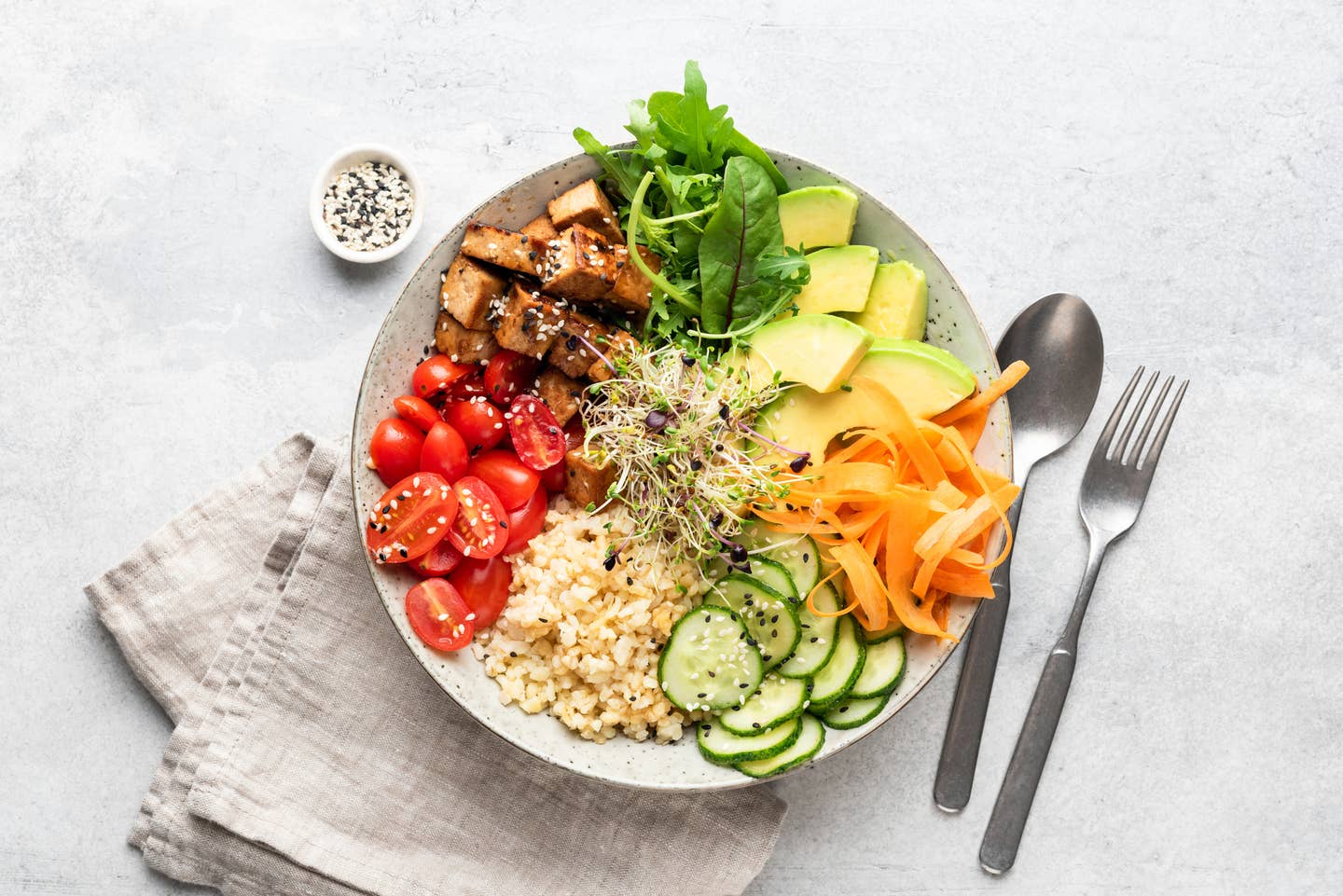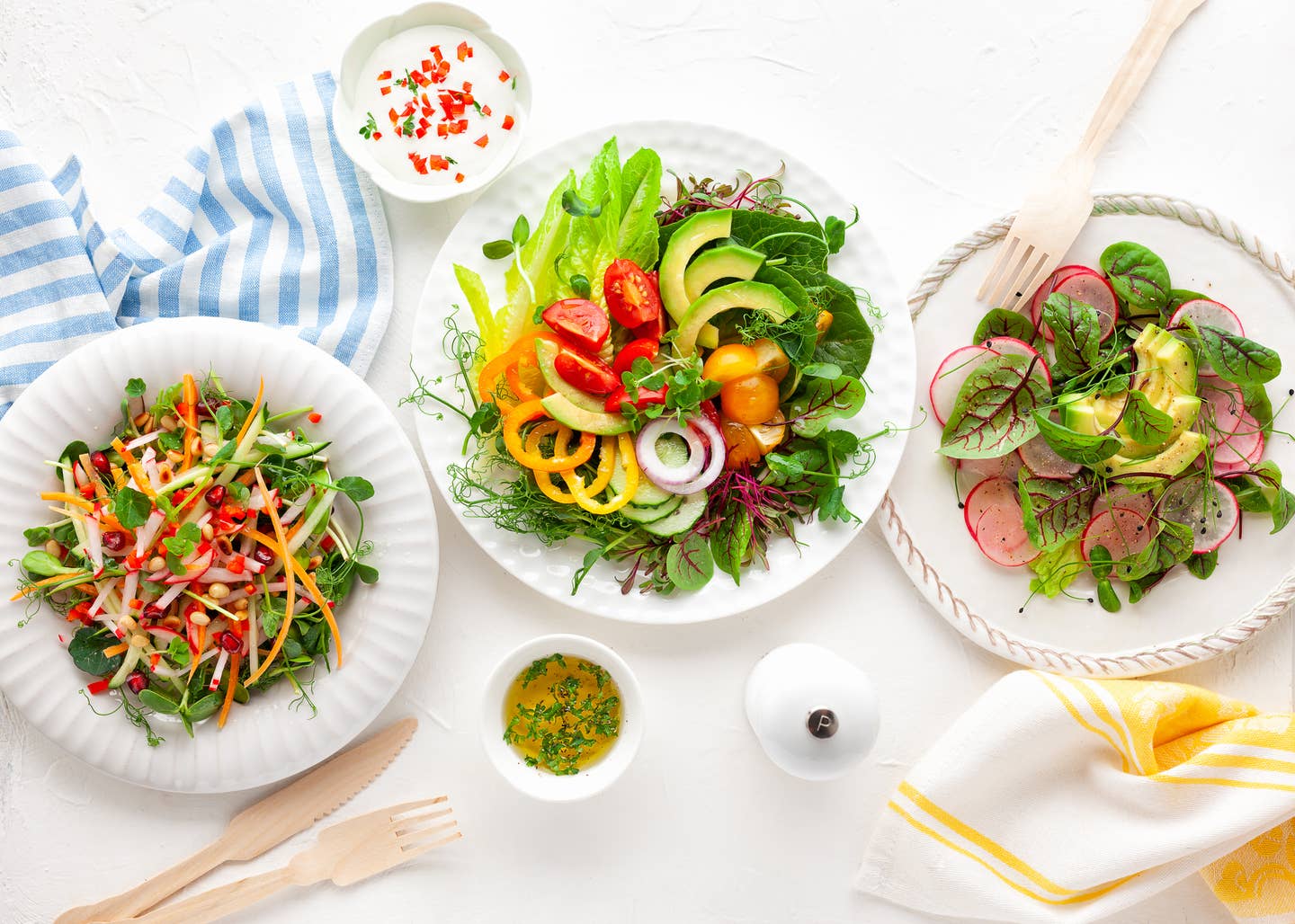
The Easiest Way to Start a Vegan Diet is One Meal a Day, a Nutritionist Says
The world is changing, and you’re likely spending more time at cooking than ever before. There are so many things you can’t control during this pandemic era, so why not focus on something you can control, like your diet? If you’ve been thinking of transitioning to a plant-based diet but never had the time to research how to do it properly or cook your meals, there’s no time like the present. This plant-based starter guide will provide a roadmap for eating more plants, having higher energy levels and boosting your health.
What does "plant-based" or vegan mean?
The term “plant-based” technically doesn’t have an official definition. Some say “plant-based” when they mean vegetarian, others consider it vegan. It’s really up to you to decide what type of plant-based diet works best for you. As a reminder, vegetarian diets include all plants, dairy, and eggs, while vegan is plant foods with absolutely no animal products (not even honey).
Why you should try a plant-based diet
There is no denying that plant-based foods are rich in nutrients that help you feel great on a daily basis. Plants are chock full of vitamins, minerals, antioxidants, and fiber, all of which play a crucial role in your overall health. For example, the best sources of immune-boosting Vitamin C comes from plants, like citrus, peppers, and strawberries. Minerals, like potassium and magnesium, play a role in regulating blood pressure and keeping the heart-healthy, and they are abundant in bananas, potatoes, leafy greens, and more. Not to mention that basically all plant-based foods have fiber, which contributes to digestion and heart health, as well as antioxidants, which reduce inflammation.
If that’s not enough, it seems like more and more research is published daily in favor of a plant-based diet. A brand new study in JAMA Internal Medicine found replacing animal proteins, such as meat and eggs, with plant-based proteins may reduce the risk of premature death and death from cardiovascular disease. Another research study concluded that following a plant-based whole foods diet for 6 months improved BMI and cholesterol levels.
Tips for starting a plant-based diet
If you’re ready to jump on the plant-based train, we are here to help! Like any diet change, having a plan is the best way to successfully make a change and stick with it. Follow these tips to be on your way to plant-based nirvana.
Start with one plant-based meal a day
When you’re completely new to a style of eating, going all-in on your first day can be daunting. Instead, start with just one plant-based meal a day for a week. Then add in a second meal, then a third meal, and before you know it you are eating plant-based.
Switching to one plant-based meal a day for a year also helps reduce the impact your food has on the environment, and more consumers than ever are making the change because of their concern for the planet, according to a new survey. Eating just one more plant-based meal a day is enough to save the same carbon emissions as driving from LA to New York.
Breakfast is simple: Start with your first meal, since you can easily make plant-based smoothies, oatmeal or loaded toast, with avocado or chickpea spread.
For lunch, try this easy salad: A big leafy green lunchtime salad is a straightforward and healthy option. Make sure you incorporate some sort of protein, like chickpeas, lentils or quinoa, which add bulk to the salad and keep you full.
Add a plant-based dinner: Your favorite pasta, with red sauce, vegetables, meatless meat, and vegan parmesan cheese is a great start. Or try a veggie-loaded pizza with plant-based mozzarella cheese. The Beet has tried shredded cheeses to determine which ones we love best.
Know your plant-based proteins
Protein is important for muscle building, but it also plays a major role in hunger and appetite. Without enough protein in your diet, chances are that you’ll feel hungry all the time. This is actually one of the major complaints I receive as a nutritionist, from many of my clients who transition to a plant-based diet. They need to learn where to get their plant-based proteins. The simple way to avoid the hunger trap is to make sure you eat plant-based protein at every meal. Here are some examples:
- Breakfast: Fruit smoothie with tofu (or vegan protein powder)
- Lunch: Quinoa salad with tons of veggies
- Snack: Roasted crunchy chickpeas or nuts
- Dinner: Tempeh stir-fry with protein-packed vegetables.
Here are 20 Vegetables with the Most Protein Per Serving
Pay attention to Iron and Vitamin B12
Iron delivers oxygen through the blood to the tissues, and Vitamin B12 is necessary for blood cell formation and energy production. These two nutrients are notable for plant-based eaters because they are a little bit tougher to find in plants, but definitely not impossible. With strategic meal planning, you can get plenty of iron from foods like lentils, chickpeas, oats and tofu, and Vitamin B12 is found in nutritional yeast, fortified plant milks and fortified cereals. If you feel a major dip in your energy levels after going plant-based, consider how much protein, iron, and Vitamin B12 you’re eating. Your doctor can measure the status of these two nutrients levels in the body with a simple blood test.
Avoid processed foods which can contribute to weight gain
It’s no secret that eating tons of processed foods isn’t great for you (and can actually cause weight gain). That also goes for vegan processed foods. Although there are a ton of plant-based packaged foods hitting store shelves, the best way to eat a healthy plant-based diet is to stick to whole foods. Of course, it’s okay to enjoy a processed treat here and there. Everything in moderation!
Top 10 Sources of Plant-Based Protein According to a Nutritionist
1. Seitan
Protein: 21 grams in ⅓ cup (1 ounce) Seitan isn’t as popular as other proteins, but it should be! Made from wheat gluten, its texture resembles ground meat. It’s often used in pre-made veggie burgers or meatless nuggets. Seitan has a savory taste, like mushrooms or chicken, so it works well in dishes that call for an umami flavor. With a hearty texture, seitan can be the star of practically any vegan main dish. Add it to stir-fries, sandwiches, burritos, burgers, or stews. Like tofu, seitan will take on the flavor of any marinade or sauce.
2. Tempeh
Protein: 16 grams in 3 ounces If you like a protein with a bit of bite, add tempeh to your list. Made from fermented soybeans, tempeh has a slightly nutty flavor and is pressed into a block. Most varieties include some sort of grains, such as barley or millet. Not only is tempeh a plant-based source of protein, but the fermentation process also creates good-for-your-gut probiotics. You can cut tempeh right off the block and use it as the base for a sandwich or pan-fry it with some sauce. Or, crumble, heat, and make it the star of your next taco night.
3. Lentils
Protein: 13 grams in ½ cup cooked Lentils come in multiple varieties--red, yellow, green, brown, black. Regardless of the type lentils are small but mighty nutritional powerhouses. They pack a good amount of protein as well as iron, folate, and fiber. When cooked, brown lentils retain their texture and can be the base for a grain bowl or make a hearty substitute for ground meat in meatballs, lasagna, tacos or Bolognese. Red lentils are a bit softer and make a nice add-in for a hearty soup, chili, or stew.
4. Hemp Seeds
Protein: 10 grams in 3 tablespoons Hemp seeds are a tender and nutty seed, derived from the hemp plant. They contain good amounts of omega-3s, iron, folate, magnesium, phosphorus, and manganese. They are also a solid source of both soluble and insoluble fiber, which helps to keep your digestive tract healthy and humming. Because they pack a double whammy of protein and healthy fats, hemp seeds can help satisfy hunger, preventing those embarrassing stomach growls as you slog your way to your lunch break. Add them to your morning smoothie or sprinkle them on top of yogurt, oatmeal, or even a salad.
5. Tofu
Protein: 9 grams in 3 ounces (⅕ of a block) Made from coagulated soybeans, tofu is the most popular plant-based protein. Soy is one of the only meatless "complete" proteins, meaning that it contains all of the essential amino acids that the body can’t make but needs for muscle and immune function. With 15% of your daily calcium needs, tofu is also a good replacement for dairy.
6. Edamame
Protein: 9 grams of protein in ½ cup This sushi appetizer is a nutrient powerhouse, so eat it anytime. Edamame is really just another name for soybeans in their pods. Let’s list off some stats--a small ½-cup serving of edamame has 9 grams of protein, 15% of your daily vitamin C, 10% of your daily iron and 16% of your daily fiber. Keep a bag of edamame in your freezer to serve as a fun-to-eat side dish or opt for the shelled variety to toss into salads or a grain bowl.
7. Quinoa
Protein: 8 grams per cup (cooked) Quinoa is an ancient grain and since it's gluten-free a great choice for anyone avoiding gluten. Add it to your burger recipe to create filling texture, or instead of meat in your taco or burrito. Quinoa is among the healthiest foods on the planet, delivering phytonutrients that have anti-inflammatory qualities, so keep it in your pantry for any meal that needs a filling grain. Just remember to soak it and rinse before cooking to get rid of any bitter taste.
8. Black Beans
Protein: 7 grams in ½ cup (canned) Eating beans on the regular might as well be a prerequisite for a plant-based diet. Not only are canned black beans inexpensive, but they also contribute 10% of your daily iron and 25% of your daily fiber to your diet. For less than $1 a can, beans can be the star of tacos, quesadillas, salads, soups, burgers, or dips.
9. Amaranth
Protein: 6 grams in ⅔ cup (cooked) Chances are you’ve never cooked amaranth. But you should, since this tiny, gluten- free grain is packed with almost 30% of your daily fiber and 20% of your daily iron. Cook it like a traditional grain to yield a soft, porridge-like texture. Many people add amaranth to other a hot breakfast cereal mixture, like oats and quinoa. It also pops like popcorn. Toss it in a pot with some oil and wait for it to pop up into a nutritious snack.
10. Peas
Protein: 5 grams in ⅔ cup If peas were one of your most hated veggies as a kid, it’s time to give them another chance. These green beans are a great low-calorie protein to keep in your freezer. Sure, they don’t always taste great when steamed or microwaved (who wants to eat mushy, overcooked peas?), but they do blend well into a yummy puree that can be slathered on toast. To amp up the flavor, add some lemon juice or mint to your mix before you blend.
More From The Beet






